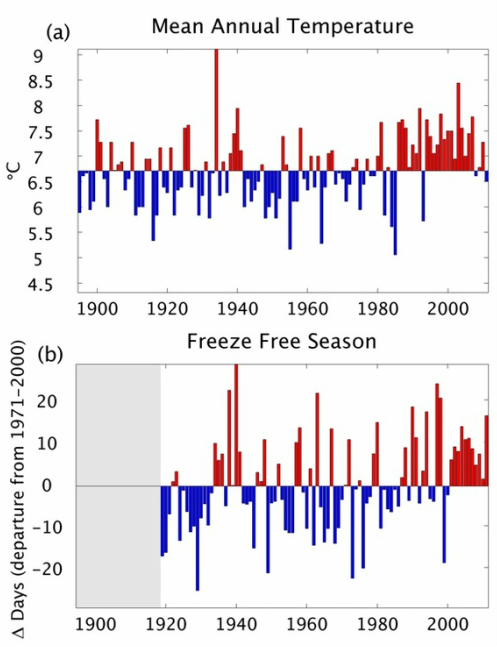Warmer temperatures and a longer frost-free growing season
Air temperatures and changes in growing season are closely linked (1). As average air temperatures increase, the daily minimum temperatures have risen faster than daily maximum temperatures (6). In other words, most of the global increase in temperature has happened at night. Night time minimum temperatures in the spring and fall determine first and last frost days. Most areas of the US have experienced fewer frosts overall, as well as longer growing seasons. In the Pacific Northwest, the growing season has increased by 4 days per decade (1).
The US Historical Climatology Network Daily Data includes data from twelve locations that were chosen throughout Idaho (7). All locations had data from 1919 to 2009 and were missing less than 10% of all data during that time. The elevations of these stations range from 640-1807 m (2100-6000 ft) above sea level. The last spring day and first fall day with a minimum temperature less than 0° C (32° F) were used to find the growing season length for each location. The average number of days in the growing season for all 90 years was used to find the difference between each year’s growing season length and the 90 year average. Earlier years generally had shorter growing seasons than the average, while later years generally had longer growing seasons than the average.
The growing season in Idaho is approximately 13 days longer now than it was in the early 20th century. The Idaho growing season is both starting sooner and ending later. The last spring frost is on average, 8 days earlier, and the last fall frost is 5 days later. While some of the benefits of the longer growing season can be seen as positives, negative effects also exist.
References
- Easterling, D.R. 2002. Recent changes in frost days and the frost-free season in the United States. Bulletin of the American Meteorological Society. 83: 1327-1332.
- Inouye, D.W. 2008. Effects of climate change on phenology, frost damage, and floral abundance of montane wildflowers. Ecology. 89:353-362.
- Jones, G.V. 2005. Climate change in the western United States grape growing regions. Acta Hort. 689:41-60
- Motha, R.P., W. Baier. 2005. Impacts of present and future climate change and climate variability on agriculture in the temperate regions: North America. Climatic Change. 70:137-164.
- Scheifing, H., A. Menzel, E. Koch, and Ch. Peter. 2002. Trends of spring time frost events and phonological dates in Central Europe. Theor. App. Climatol. 74: 41-51.
- Vose, R. S., D. R. Easterling, and B. Gleason. 2005. Maximum and minimum temperature trends for the globe: An update through 2004. Geophys. Res. Lett., 32.
- Daily observations of minimum temperature from National Weather Service Cooperative Observed Program were acquired from the United States Historical Climate Network (USHCN, http://cdiac.ornl.gov/ftp/ushcn_daily/, last accessed, May 13, 2011).
- Cannon, R. J. C. (1998), The implications of predicted climate change for insect pests in the UK, with emphasis on non-indigenous species. Global Change Biology, 4: 785–796.
- Bale, J. S., Masters, G. J., Hodkinson, I. D., Awmack, C., Bezemer, T. M., Brown, V. K., Butterfield, J., Buse, A., Coulson, J. C., Farrar, J., Good, J. E. G., Harrington, R., Hartley, S., Jones, T. H., Lindroth, R. L., Press, M. C., Symrnioudis, I., Watt, A. D. and Whittaker, J. B. (2002), Herbivory in global climate change research: direct effects of rising temperature on insect herbivores. Global Change Biology, 8: 1–16.
- Hellman, J. J., Byers, J. E., Bierwagen, B. G. and Dukes, J. S. (2008), Five Potential Consequences of Climate Change for Invasive Species. Conservation Biology, 22: 534–543.

